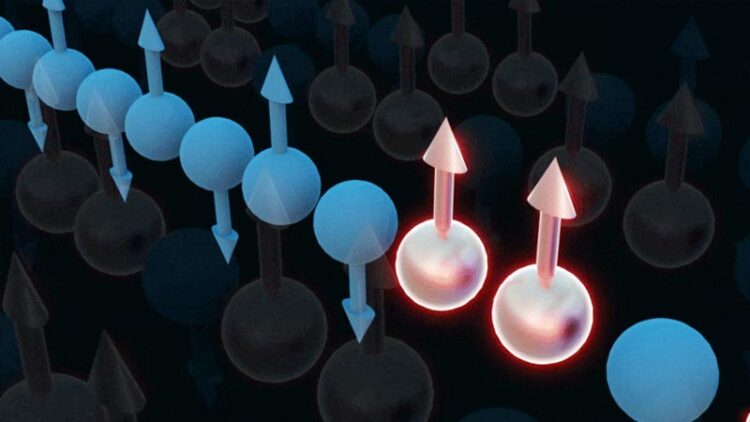Subtle spin: A novel study of quantum material proves theoretical predictions

When quasiparticles cluster together, they cause spin chains in a quantum system to undergo a collective twisting motion. In this animation, neighboring spins in red point upward because of this motion, while their peers in blue alternate direction.
Image courtesy of Michelle Lehman, Oak Ridge National Laboratory
Interactions of quantum “quasiparticles” demonstrate unusual fluid flow.
The Science
Researchers have discovered a hard-to-observe type of spin in a quantum mechanical system. In physics, a quantum mechanical system is a set of components that interact at the quantum scale. This is the realm of atoms and subatomic particles such as those defined in the Standard Model of Particle Physics. Spins are magnetic particles in a quantum system. The researchers successfully simulated and measured how spins can exhibit a type of motion known as Kardar-Parisi-Zhang (KPZ) in solid materials at various temperatures. Their findings demonstrate that KPZ motion accurately describes the changes in time of spin chains—linear channels of spins that interact with one another—in certain quantum materials.
The Impact
This marks the first time scientists have found evidence of KPZ dynamics in quantum materials. Scientists have previously found KPZ dynamics only in soft matter and other classical materials, where conventional forces predominate over quantum mechanics. The novel analyses allowed the team to obtain new insights into the properties of fluids and other underlying features of quantum systems. This knowledge could eventually be harnessed for real-world applications. For example, it could help improve heat transport capabilities using spin chains. It could also facilitate future efforts in the field of spintronics, which saves energy and reduces noise that can disrupt quantum processes by manipulating a material’s spin instead of its charge.
Summary
In quantum mechanics, spins proceed from place to place in two ways. In ballistic transport, spins travel freely through space. In diffusive transport, spins bounce off impurities in the magnetic material—or each other—and slowly spread out. But fluid spins are unpredictable, sometimes displaying unusual movement. One example is KPZ dynamics, an intermediate category between the two standard forms of spin transport. In this case, quasiparticles roam randomly throughout a material and affect every other particle they touch. Using resources from Oak Ridge National Laboratory’s Compute and Data Environment for Science and Spallation Neutron Source, the Lawrencium computational cluster at Lawrence Berkeley National Laboratory’s Laboratory Research Computing center, and the National Energy Research Scientific Computing Center, the team first simulated KPZ behavior demonstrated by a single spin chain in potassium copper fluoride. Next, they examined a previously unexplored region within a crystal sample of the material to measure the KPZ activity of real, physical spin chains. Both methods revealed evidence of KPZ dynamics at room temperature, a surprising accomplishment considering that quantum systems usually must be cooled to almost absolute zero to display quantum mechanical effects.
Funding
This work was funded by the Department of Energy Office of Science. Additional support was provided by the Quantum Science Center, a DOE Office of Science National Quantum Information Science Research Center, and the Simons Foundation’s Investigator program.
Journal: Nature Physics
DOI: 10.1038/s41567-021-01191-6
Method of Research: Experimental study
Subject of Research: Not applicable
Article Title: Detection of Kardar–Parisi–Zhang hydrodynamics in a quantum Heisenberg spin-1/2 chain
Article Publication Date: 11-Mar-2021
Media Contact
Michael Church
DOE/US Department of Energy
michael.church@science.doe.gov
Office: 2028416299
All latest news from the category: Physics and Astronomy
This area deals with the fundamental laws and building blocks of nature and how they interact, the properties and the behavior of matter, and research into space and time and their structures.
innovations-report provides in-depth reports and articles on subjects such as astrophysics, laser technologies, nuclear, quantum, particle and solid-state physics, nanotechnologies, planetary research and findings (Mars, Venus) and developments related to the Hubble Telescope.
Newest articles

Innovative 3D printed scaffolds offer new hope for bone healing
Researchers at the Institute for Bioengineering of Catalonia have developed novel 3D printed PLA-CaP scaffolds that promote blood vessel formation, ensuring better healing and regeneration of bone tissue. Bone is…

The surprising role of gut infection in Alzheimer’s disease
ASU- and Banner Alzheimer’s Institute-led study implicates link between a common virus and the disease, which travels from the gut to the brain and may be a target for antiviral…

Molecular gardening: New enzymes discovered for protein modification pruning
How deubiquitinases USP53 and USP54 cleave long polyubiquitin chains and how the former is linked to liver disease in children. Deubiquitinases (DUBs) are enzymes used by cells to trim protein…


